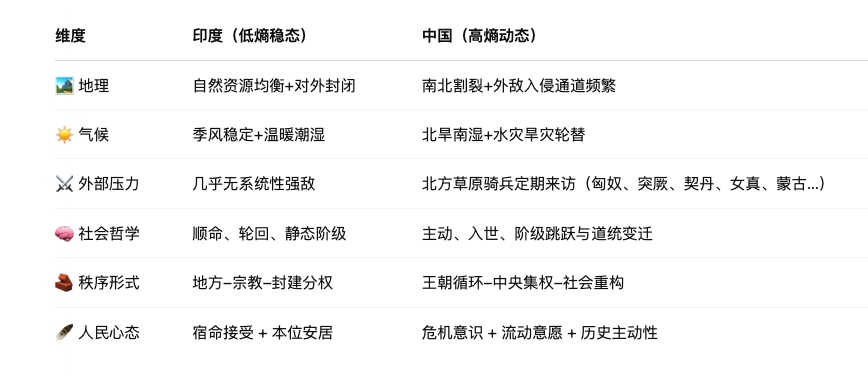The roots of the Indian caste system lie in the fact that ancient India was a low-entropy society.
✅ The Indian caste system is a stable structural state under low-entropy geography + low external enemy pressure + high religious penetration, while China, due to high-entropy shocks + geographical challenges + political turmoil cycles, is destined to require a high-intensity, fluid, unified central power system.
Early Indian society did not experience high-density survival anxiety and emphasized "conforming to nature – being content with one's position." In other words, due to the rarity of external enemies and sufficient food production, even the lowest strata of people would generally not starve. Under this stable state, land would inevitably concentrate in the hands of high-caste individuals, and at this point, the caste system became a long-term stable existence. In other words, this is a low-entropy, low-external-stimulation society, perhaps suitable for a caste system.
In contrast, China is a relatively high-entropy society, with northern nomadic tribes regularly invading, the Yellow River's course requiring significant cooperation, and the north often becoming a battlefield during dynastic cycles. The south developed later and was also influenced by northern people moving south, thus failing to maintain a low-entropy state - for example, after the Song Dynasty unified the north, it quickly unified the south. This necessitated China to adopt a higher-entropy structure - the civil service system.

免责声明:本文章仅代表作者个人观点,不代表本平台的立场和观点。本文章仅供信息分享,不构成对任何人的任何投资建议。用户与作者之间的任何争议,与本平台无关。如网页中刊载的文章或图片涉及侵权,请提供相关的权利证明和身份证明发送邮件到support@aicoin.com,本平台相关工作人员将会进行核查。




